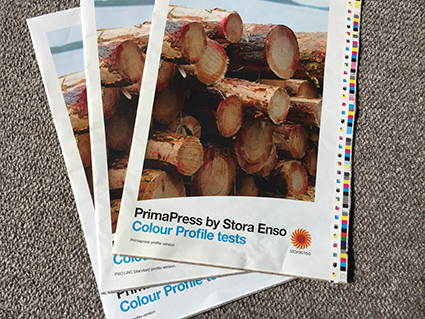Stora Enso provides an ICC profile for their PrimaPress publication papers
 So why does PrimaPress need a ‘special’ profile?
So why does PrimaPress need a ‘special’ profile?
PrimaPress is a lightweight uncoated (LWU) mechanical paper with lightweight coated (LWC) properties. PrimaPress has a brilliant print gloss, high whiteness, opacity as well as with excellent runnability. It is for heat set web offset production and designed to replace lightweight coated papers.
The standard range of PSO LWC profiles used in this market are now nearly ten years old and in many cases do not reflect the latest developments in the light-weight publications paper markets.
PrimaPress is one of these developments. It is an uncoated paper, which by using an advanced super calendaring method by Stora Enso looks, feels and behalves like a lightweight coated paper.
However the ‘matching’ Fogra 46 based PSO LWC Standard ICC profile is not optimised for this hybrid paper.
So Stora Enso started an extensive project to research and develop an ICC profile, based on current ISO and PSO standards and specifications for this paper.
The PrimaPress profile is based on the PSO LWC Standard (Lightweight coated), Fogra46 data set from ECI. The white paper point of this dataset closely matches the white of PrimaPress.
The TAC, total area coverage was set at 260% with maximum GCR (Grey Component Replacement). This will provide better press colour stability,Improved grey balance control, less paper deformation and should show ink savings of up to10% over the conventional ICC profiles.
It should used be to convert images within the standard desktop publishing software’s when saving to PDF, such as Adobe CS, CC and QuarkXpress, or within other specialised colour management modules and servers within designers and printers workflows.
For the technical minded the Fogra 46 dataset was first processed using ColorLogic’s ColorAnt dataset optimization tool. This optimised and amended dataset was then taken into ColorLogics Copra colour profiling software to produce the PrimaPress ICC profile to the parameters quoted above.
TVI, tone value increase remains as Fogra 46, using curves B and C from ISO 12647/2 2004 Amd 1 2007.
The CMYK primaries also have the same Lab figures as Fogra 46. All Lab figures are based on M0 spectrophotometer readings.
The images wee from Stora Enso and the VIGC 50 XCS test suite, all in RGB before conversion to the test CMYK profiles.
Charlie Pett, Stora Enso’s Technical Support Manager in the UK, lead the project with support from Paul Sherfield from the Missing Horse Consultancy.
Extensive testing was carried out using a 64pp heat set web offset press in London. From common pages and images four ICC profiles were used to convert the pages and images into four sets of test pages.
The ECI profiles that have been used with PrimaPress:
SC.icc (for standard super calendared papers)
PSO MFC.icc (for machine finished coated papers
PSO LWC Standard.icc, the Fogra 46 based profile for standard lightweight coated papers
And the new PrimaPress profile.
The four sets of pages were contract colour proofed and then printed carefully to ISO 12647/2 tolerances.
Briefly, the SC profiled print tests could not match the proof, as the white paper point and simulation on the proof is ‘set’ for much less bright super calendared papers.
The PSO MFC test was acceptable, but will its reduced colour gamut did not show the PrimaPress paper at its best.
The PSO LWC Standard was the best ECI profile for PrimaPress, however the TAC (total area coverage of the ink at 300% is not optimal for PrimaPress
The PrimaPress profile, with a TAC of 260%, high GCR and produced using the latest colour management software using the Fogra 46 dataset matched the proofs, and was considered the best result.
Charlie Pett commented, “The specially produced profile will be available to all clients using PrimaPress. As it is based on the Fogra 46 data, the standard ISO 12647/2 printing conditions, understood by most web offset printers in Europe remain unchanged. However with its lower TAC and high GCR it will be more stable on press, dry better with less paper deformation and result in up to 10% in ink savings over the standard profile’.
Twitter
- Paul Sherfield who runs the consultancy is well known in the printing and pre-media industry as having considerable knowledge on digital workflows, with a special expertise on the business reasoning behind such systems.
He has installed some of the most successful digital pre-press and pre media systems in the UK. For 2 years he worked on a number of medium term projects before starting the consultancy in July 2000. Before this he was a partner in what became one of the leading pre-press/printing companies in London.
He is active in a number of industry groups including the BPIF Technical Standards Committee, ISO TC 130 printing standards committees and is chair of the BPIF steering group for ISO 12647/2 UK certification, He is a regular speaker at seminars and conferences.



